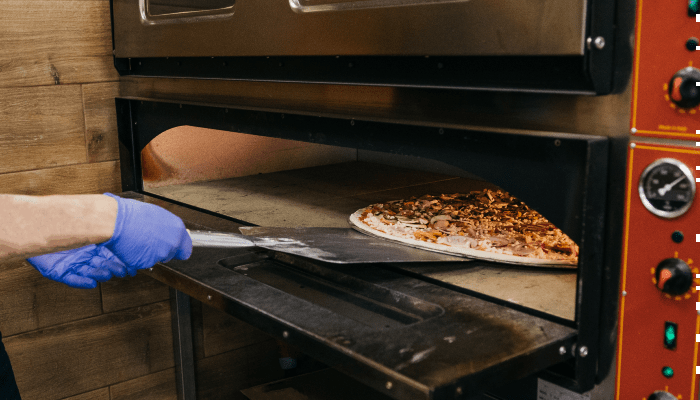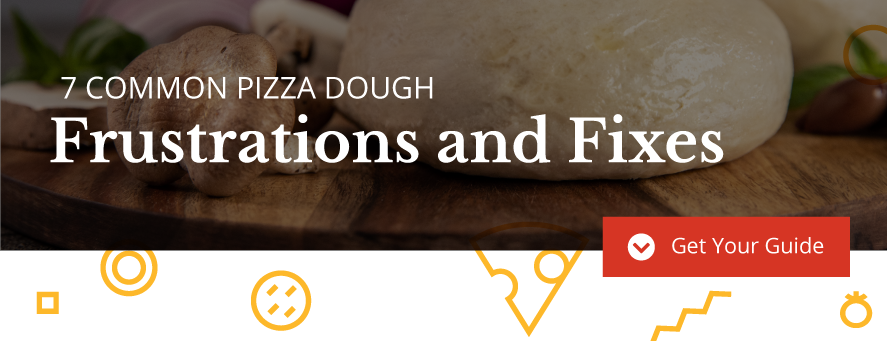
Great pizza is a thing of joy. Every bite is packed with flavor and the kinds of ingredients that would make a Michelin-starred chef happy-cry. However, if you’re the one prepping that pizza and your dough is sticking to your prep board or peel, all that joy goes right out the (oven door) window.
Read on for all things sticky, difficult pizza dough and how to prevent the dreaded result of extra dough grip and other preparation snafus, like torn, ruined pizza that never had a chance to slide neatly into your oven.
So, Should Pizza Dough Be Sticky?
In short, yes. Pizza dough should be some degree of sticky. More importantly, though, you want a dough that is strong, smooth, and stretchy.
Excess stickiness is often caused by one of these factors:
- The dough absorbed too much water
- The dough hasn’t been kneaded enough
- The dough’s flour isn’t fully incorporated
- The dough has been over-proofed
- The dough has been overhydrated from wet toppings
What to Do if Pizza Dough is Too Sticky
Here’s how to troubleshoot each of the sticky factors above.
- Too much water: If your dough is too watery, add more flour, a little at a time until the dough becomes comfortable to work with.
- Lack of kneading: We recommend kneading for 8-10 minutes if you’re doing it by hand, or 5-7 minutes if you’re using a stand mixer with a dough hook. The dough should be smooth, elastic, and tacky, but not sticky. You can also try the “windowpane test,” where you take a small piece of dough and stretch it between your fingers. If it forms a thin, see-through layer without tearing, you’re good to go. If it tears, keep kneading. But be careful. Too much kneading leads to tough crust.
- Flour isn’t fully incorporated: If flour isn’t mixed in evenly, it can clump up and leave other parts of the dough too watery and sticky. In that case, let the dough rest for a few minutes before continuing to knead.
- Over-proofing: If your dough has more than doubled in size, you should punch it down and let it rest for 10-15 minutes while it regains its structure. If you’re using dough balls, hitting the 48 to 72-hour proofing "sweet spot" is essential. Follow these best practices to ensure the perfect proof time.
- Overhydration: Avoid too many wet ingredients in the dough itself and limit the use of watery toppings like veggies. Too much sauce can be troublesome, too. Pay attention to sauce distribution, especially when using a dough docker under very high heat.
Other Ways to Fix Sticky Pizza Dough
Use a Flour That’s Higher in Protein
Higher protein flours help your dough build a stronger gluten network, giving the dough more structure and elasticity that help it absorb more water without becoming too sticky. Think …
- Durum
- Semolina (also made from durum wheat)
- Whole wheat flour
Try a Different Peel Dust
Many chefs simply use flour, but flour requires quick work to keep the dough in constant motion to prevent it from sticking. We prefer cornmeal to conventional flour as a peel dust, as it adds a coarse texture to the bottom of the crust, or “alternative” flours that are slower to absorb water (see our list above).
Whatever you choose as a peel dust, be sure to regularly clean your oven to prevent smoking and black, charred spots on the bottom of your crust.
The Best Pizza Peel to Avoid the Stick Factor
What’s the best pizza peel to use? The answer depends on the task at hand. If you’re prepping, a wood or composite peel is the right choice. Because these materials are less conductive than metal, temperature differences are less likely to create water condensation on the peel. Again, too much water is bad news. If an unbaked crust absorbs condensed water, the dough could become overly sticky.
A metal peel, on the other hand, is appropriate for the oven, but it’s important to move quickly. Because metal conducts heat so well, moving too slowly can cause the crust to begin to bake and stick to the peel.
Get More Fixes for Pizza Dough Frustrations
Expertly troubleshoot a wide range of pizza dough challenges with help from our guide, 7 Common Pizza Dough Frustrations and Fixes. You’ll also learn why you might want to consider pre-made dough balls or par-baked crusts as a solution. For instance, you’ll never under- or overshoot your proofing time with our par-baked and self-rising crusts, because they don’t require proofing at all. Get your guide below.
This blog was originally published on December 8, 2021, but updated and republished on February 2, 2025





